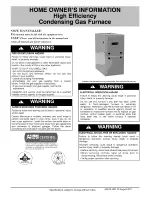
INSTALLATION INSTRUCTIONS
Gas Furnace: (F/G)9MVE
4
440 01 4401 02
Specifications subject to change without notice.
(914 mm) horizontally from the furnace. See NFPA 90B
or local code for further requirements.
Table 1
Minimum Clearances to
Combustible Materials for All Units
POSITION
CLEARANCE
In(mm)
REAR
0
FRONT (Combustion air openings in
furnace and in structure)
1 (25)
Required for service
*
24 (610)
All Sides of Supply Plenum
*
1 (25)
Sides
0
Vent
0
Top of Furnace
1 (25)
* Consult local building codes
13. These furnaces SHALL NOT be installed directly on
carpeting, combustible tile, or any other combustible
material other than wood flooring. In downflow
installations, factory accessory floor base MUST be
used when installed on combustible materials and wood
flooring. Special base is not required when this furnace
is installed on manufacturer’s Coil Assembly or when
Coil Box is used. See
for clearance to
combustible construction information.
NOTICE
IMPORTANT INSTALLATION AND START
−
UP
PROCEDURES
Failure to follow this procedure may result in a nuisance smoke
or odor complaint.
The manifold pressure, gas rate by meter clocking, temperature
rise and operation must be checked after installation. Minor
smoke and odor may be present temporarily after start
−
up from
the manufacturing process. Some occupants are more
sensitive to this minor smoke and odor. It is recommended that
doors and windows be open during the first heat cycle.
Introduction
The 4
−
way multipoise Category IV condensing furnace is CSA
design
−
certified as a direct vent (2
−
pipe) or non
−
direct vent
(1
−
pipe) furnace. (See
factory
−
shipped for use with natural gas. The furnace can be
converted in the field for use with propane gas when a
factory
−
supplied conversion kit is used. Refer to the furnace
rating plate for conversion kit information.
This furnace is not approved for installation in mobile homes,
recreational vehicles, or outdoors.
This furnace is designed for minimum continuous return
−
air
temperature of 60
°
F (15
°
C) db or intermittent operation down to
55
°
F (15
°
C) db such as when used with a night setback
thermostat. Return
−
air temperature must not exceed 80
°
F
(27
°
C) db. Failure to follow these return
−
air temperature limits
may affect reliability of heat exchangers, motors, and controls
The furnace should be sized to provide 100 percent of the
design heating load requirement plus any margin that occurs
because of furnace model size capacity increments. None of
the furnace model sizes can be used if the heating load is
20,000 BTU or lower. Use Air Conditioning Contractors of
America (Manual J and S); American Society of Heating,
Refrigerating, and Air
−
Conditioning Engineers; or other
approved engineering method to calculate heating load
estimates and select the furnace. Excessive oversizing of the
furnace may cause the furnace and/or vent to fail prematurely,
customer discomfort and/or vent freezing.
Failure to follow these guidelines is considered faulty
installation and/or misapplication of the furnace; and resulting
failure, damage, or repairs may impact warranty coverage.
For accessory installation details, refer to the applicable
instruction literature.
NOTE:
Remove all shipping materials, parts assemblies and
literature before operating the furnace.
Figure 1
Freeze Protection and Return Air
Temperature
32
°
F/0
°
C MINIMUM INSTALLED
AMBIENT OR FREEZE
PROTECTION REQUIRED
SUPPLY AIR
MAX 80
°
F/27
°
C
MIN 60
°
F/16
°
C
A10490
Codes and Standards
Follow all national and local codes and standards in
addition to these instructions.
The installation must comply
with regulations of the serving gas supplier, local building,
heating, plumbing, and other codes. In absence of local codes,
the installation must comply with the national codes listed
below and all authorities having jurisdiction.
In the United States and Canada, follow all codes and
standards for the following:
Safety
US: National Fuel Gas Code (NFGC) NFPA
54
−
2012/ANSI Z223.1
−
2012 and the Installation
Standards, Warm Air Heating and Air Conditioning
Systems ANSI/NFPA 90B
A manufactured (Mobile) home installation must
conform with the Manufactured Home Construction
and Safety Standard, Title 24 CFR, Part 3280, or
when this standard is not applicable, the Standard for
Manufactured Home Installation (Manufactured Home
Sites, Communities, and Set-Ups),ANSI/NCS A225.1,
and/or CAN/CSA-Z240, MH Series Mobile Homes
CANADA: National Standard of Canada, Natural Gas
and Propane Installation Code (NSCNGPIC)
CAN/CSA B149.1
−
2010
General Installation
US: NFGC and the NFPA 90B. For copies, contact the
National Fire Protection Association Inc.,
Batterymarch Park, Quincy, MA 02269; or for only the
NFGC contact the American Gas Association, 400 N.
Capitol, N.W., Washington DC 20001.
CANADA: NSCNGPIC. For a copy, contact Standard
Sales, CSA International, 178 Rexdale Boulevard,
Etobicoke (Toronto), Ontario, M9W 1R3, Canada.





































